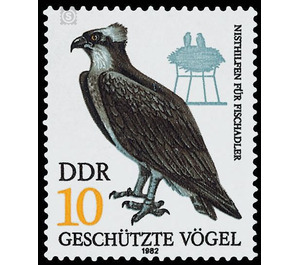Protected birds of prey - Germany / German Democratic Republic 1982 - 10 Pfennig
Theme: Animals
| Country | Germany / German Democratic Republic |
| Issue Date | 1982 |
| Face Value | 10.00 |
| Color | multi-colored |
| Perforation | K 14 |
| Printing Type | Rotogravure 2 |
| Stamp Type | Postage stamp |
| Item Type | Stamp |
| Chronological Issue Number | 2444 |
| Chronological Chapter | GER-DDR |
| SID | 675443 |
| In 27 Wishlists | |
Protected birds With the illustrations of protected birds, the Ministry of Posts and Telecommunications of the German Democratic Republic issues four multicolored special postage stamps. Special Cancellation from May 18 to July 17, 1982 Protected Birds Our birds of prey, as the final members of food chains, are among the most endangered species of birds as a result of the world's increased environmental pollution. Seven birds of prey occurring in the GDR were classified as "threatened with extinction" on the basis of § 14 of the Nature Conservation Order of 14 May 1970 and the order to protect wild plants and non-huntable, wild animals of 6 July 1970 and thus have the highest protection status. 10 Pfennig value: Osprey with nesting aid The osprey was originally distributed almost worldwide. His food is mainly fish. In many countries, there has been a strong pollution of waters and fish as well as great concern about declines or the extinction of populations. He enjoys special protection in the GDR. He partially breeds far away from its food waters on waste wood or power pylons. By horticultural measures of the state forestry enterprises, such as leaving Horstbäumen and each suitable Überhältern, the limitation of necessary utilization work to the period from 1 September to 31 December in a 300-m radius around the Horstbaum, the education of the fishermen about its rarity and partially usefulness by eating sick fish, replacing fallen fallows with artifacts, as well as by attaching shelters to pylons, the ospreys were effectively protected in intensifying forestry and fish production. The replacement of DDT-containing crop protection products in agriculture and the ever better compliance with the standards for the use of other chemical means have led to a decline in stocks end of the sixteens years and again for several years in April 80 breeding pairs after their return the winter quarters in southern Africa their brood trees refer to us.


